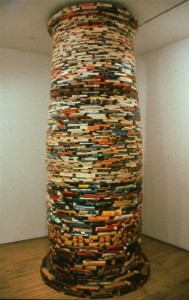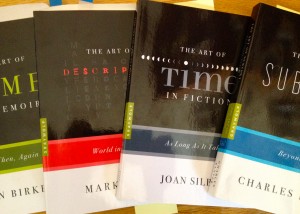 This began as a blog about writing books I love, inspired by Jane Friedman’s recent post of her five favorite writing prompts books. I started pulling my favorites from my bookshelves and the pile by my desk got higher and higher. Treacherously so. I realized a blog about all the writing books I love and use regularly would be, well, a book about writing books.
This began as a blog about writing books I love, inspired by Jane Friedman’s recent post of her five favorite writing prompts books. I started pulling my favorites from my bookshelves and the pile by my desk got higher and higher. Treacherously so. I realized a blog about all the writing books I love and use regularly would be, well, a book about writing books.
I started winnowing.
I noticed in the stack were seven books by the same publisher: Graywolf Press; four of these from The Art of Series, edited by Charles Baxter. I decided to limit this post to these books. I’ve been reading and rereading them for years and when I do, I feel as though I’m studying with the masters.
 My first of the series, though not the first released, was The Art of Description, World into Word by Mark Doty. I adore his work and who better to write about the art of description but a poet who does just that—makes art from descriptions. This is how he begins:
My first of the series, though not the first released, was The Art of Description, World into Word by Mark Doty. I adore his work and who better to write about the art of description but a poet who does just that—makes art from descriptions. This is how he begins:
It sounds like a simple thing, to say what you see. But try to find words for the shades of a mottled sassafras leaf, or the reflectivity of a bay on an August morning, or the very beginnings of desire stirring in the gaze of someone looking right into your eyes.
Next I ordered The Art of Subtext, Beyond Plot, by Charles Baxter. I do love subtext. My copy of this book is littered with sticky notes and page tags, marking passages that illustrate how great writers have used subtext to evoke what lies beneath the words on the page. Baxter has me believing I can do it, too.

“Compressing time is what all fiction does…” Joan Silber tell us in The Art of Time in Fiction, As Long as It Takes. But what to compress and what to summarize? And how to travel between the “then” and “now” of the story? And what about slow motion in narrative? Examples abound on these pages.
 My current read in the series is The Art of Time in Memoir, Then, Again by Sven Birkerts. I don’t write memoir (yet) but many in my classes and workshops do and that tricky question of when to use the voice of the “then” narrator and when to use the voice of the reflective narrator almost always comes up. Birkerts’ examples illustrate this and so much more.
My current read in the series is The Art of Time in Memoir, Then, Again by Sven Birkerts. I don’t write memoir (yet) but many in my classes and workshops do and that tricky question of when to use the voice of the “then” narrator and when to use the voice of the reflective narrator almost always comes up. Birkerts’ examples illustrate this and so much more.
These books in The Art of Series serve as my morning meditation books; I read them as I drink my coffee, sticky-noting them, copying passages in my commonplace journal or on scraps of paper to quote to my students, and, I hope, lodge somewhere in my mind to surface as I write.
Two books in series I’m looking forward to: The Art of the Ending by Amy Bloom and The Art of the Voice by ZZ Packer. Graywolf also publishes several in the series devoted to poetry.
What are your current favorite writing books? Do you read them once and put them away, or do you study them again and again?


Oh my goodness! Awesome article dude! Thank you so much, However I am having issues with
your RSS. I don’t understand the reason why I can’t join it.
Is there anybody having the same RSS problems? Anybody who knows the
solution will you kindly respond? Thanx!!
I am totally hooked on The Art of… series. I just finished reading Subtext, and now I’m reading Time in Memoir. Really looking forward to The Art of the Ending.
Hi Paula,
I know “The Art of Ending” is one I’m looking forward to also. These are all terrific books to read again and again. Thanks so much for your comment.
Howdy! Do you know if they make any plugins to protect against hackers?
I’m kinda paranoid about losing everything I’ve worked hard on.
Any suggestions?
I back it up on a disk and then back it up on a second disk named “Backup.” Before you buy a more up to date computer (that changes the minute you pay and leave the store) put it on Documents and transfer it to a disk that fits the new computer.
Nothing protects against hackers.
Hi Race Car Crashes,
I’m sorry I’m not the techie person on my website. But I betcha WordPress help can help. good luck!
These books all look amazing — now I have to go buy them all. Of course, A Writer’s Book of Days is still among my favorites of all. Thanks for this post, Judy!
And you can be sure, Midge, that in my original stack of favorites Everyday Writing was one of the first off the shelf. I’m loving your new book, too. And yes, I recommend all in The Art of Series. Thanks for your comment & shout out for my book, too. Writers supporting writers, you do it beautifully.
My favorite writing books are varied and well used. Yes, I turn down the pages that interest me, so that when I pick up the book, I know I want to reread this one.
Some of my favorites are:
Shimmering Images by Lisa Norton
A Writer’s Space by Eric Maisel
The 9 Modern Day Muses by Jill Badonsky
Outlining Your Novel by K.M. Weiland
Write Great Fiction by James Scott Bell
90 Day Novel by Sarah Doment
A Writer’s Book of Days by Judy Reeves
Breathing Life Into Your Characters by Rachel Ballonj
Those are a few of my favorite writing books.
Hi Helene,
Some of your favs are mine, too and you’ve introduced me to some new ones as well. (and thanks for mentioning Writer’s Book of Days). One of the books I didn’t know is Shimmering Images by Lisa Norton; I love to say that title outloud. Thanks so much for writing.
Do you count “technical” books?
My go-to-for-answers to wordy puzzles is John B. Bremner’s WORDS ON WORDS.
The subtitle is “A Dictionary for Writers and Others Who Care About Words.”
He was my journalism professor at USD in the 1960s.
They all count, Chuck. I don’t know this book either. I love books on words. Sometimes I just pull out my tattered old thesaurus and read the words aloud, just for the sound of them.
Thanks for posting. Hope all is well in Chuckography land.
I loved your article. I did not know there were so many books out there. I will definitely be buying these books. The book I have read and re-read is “On Writing” by Stephen King. I also have “Twenty Master Plots” by Ronald Tobias, “Book in a Month” by Writer’s Digest Books, “Fiction Writer’s Workshop” by Novakovich, “Characters and Viewpoint” by Orson Scott Card. I also like to check books out of the library but I can’t put sticky notes on them. Thanks again for the article.
Debbie
My first issue of Days came after I saw it (I think I ordered it in, I order tons of books in) and checked it out. Then I bought a copy. I always check out books that way and if I love them I buy them. Ahhhh Days mmmmmmmm!!
You know, I’m don’t generally read Stephen King books so I was delightfully surprised at how much I liked his “On Writing.” Thanks for introducing me to some other writing books, too. I wonder how many books on writing have been published! Sometimes I check books out of the library to give them a test drive & if I really like them and have to have them, then I buy them.
Thanks so much for your comment and list of book.
I study Judy’s Writer’s Book of Days (on my work bench aka dinner table) and Writer’s Retreat Kit although I don’t use highlighter and scribblings all over it like I do my other writing books. Did. I kept all my other books (Hagberg, Goldberg) until they went musty with age and crackly with fine dust particles and threw those in the recycle or gave them to the Friends of the Library for their sales. I scribble all over my Writer’s Digest mags too although I read those only once (they were gifts).
Linda, yer the best! Thanks for keeping my books even after they have probably gone all musty, too. Always appreciate your comments.
She didn’t mention my HowMaster either. I think we should keep writing anyway.
I will if you will.